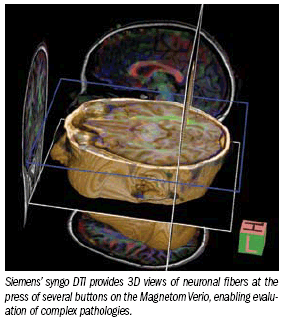Siemens taps technology to boost performance
Workflow, patient comfort, image quality rise with innovative devices and applications.
Siemens Healthcare is building on a tradition of innovation. From 0.35T to 3T and in head-to-toe clinical applications, Siemens' systems and technology have made fast, flexible, and accurate scans the rule.
This commitment to innovation is exemplified by the company's commercial release in 2003 of the Total imaging matrix. With more than 4000 systems sold, Tim has changed how MRI is performed. The accuracy, flexibility, and speed provided by Tim make patient and coil repositioning virtually unnecessary and enable reduced acquisition times. These benefits translate into workflow improvements and increased patient throughput. These, in turn, improve the bottom lines of our customers by, for example, allowing a complete examination of the central nervous system to be performed in less than 10 minutes.

In 2004, Siemens launched the Magnetom Espree, the world's first 1.5T openbore MR scanner. At a time when a 60-cm-diameter magnet bore was the standard, Espree changed the game with an expanded 70-cm bore and the shortest system length in the industry (125 cm).
Siemens' goal in combining a high-field 1.5T magnet with an open MRI was to provide advanced imaging, regardless of patient size (up to 550 pounds), without forfeiting accuracy and speed. This combination helps to better address the patient's disease states with appropriate imaging techniques, such as cardiac breath-hold studies and peripheral run-off exams.
The addition of Tim technology to these systems, then, provides more flexible access to large fields-of-view (FOV). Where traditional vertical-field open MRIs are restricted by the FOV of each individual coil, Tim allows you to combine elements from physically separate coils without patient repositioning or coil changes. This results in a much faster clinical routine that enables shorter exam times.
Just three years later, in 2007, Siemens reached a new milestone with the introduction of Magnetom Verio, the first system to combine 3T field strength, a 70-cm bore, and Tim technology. The shortest 3T system on the market today, Verio also boasts an ultralight magnet with zero helium boil-off. It provides a large FOV and supports a full range of clinical applications that can be performed at high speed and deliver high-quality images.
In addition to traditional syngo applications, Tim technology on the Magnetom Verio also allows for advanced applications, such as diffusion tensor imaging (DTI), functional MRI, non–contrast-enhanced perfusion imaging (ASL), and single- and multivoxel spectroscopy, to be performed.
The design of Siemens' 70-cm-bore systems facilitates the imaging of bariatric and claustrophobic patients and, in some cases, makes the examination even possible. The wide bore allows for fewer patient sedations, accommodates a wider range of patients, and provides easy access for interventional MR.
At last year's RSNA meeting, Siemens complemented its MR portfolio with the Magnetom Espree – Pink, a dedicated MR breast scanner that combines the wide-bore design of the Espree with the Sentinelle Vanguard, a breast coil solution that allows breast imaging and biopsy access. Magnetom Espree – Pink is upgradable to a Magnetom Espree whole-body scanner.
And now, at RSNA 2009, Siemens will innovate again with a partnership that will redefine productivity. This new introduction will allow anyone, regardless of experience level or complexity of patient need, to realize the total power of MRI, with throughput taken to the next level.
Could Ultrafast MRI Enhance Detection of Malignant Foci for Breast Cancer?
April 10th 2025In a new study involving over 120 women, nearly two-thirds of whom had a family history of breast cancer, ultrafast MRI findings revealed a 5 percent increase in malignancy risk for each second increase in the difference between lesion and background parenchymal enhancement (BPE) time to enhancement (TTE).
MRI Study Suggests Shape of White Matter Hyperintensities May Be Predictive of Cognitive Decline
April 7th 2025Emerging research demonstrated that cognitive declines in memory, executive function and processing speed domains were associated with irregular shape of periventricular/confluent white matter hyperintensities.
Can Abbreviated MRI Have an Impact in Rectal Cancer Staging?
April 4th 2025Abbreviated MRI demonstrated a 95.3 percent specificity for rectal cancer and provided strong agreement with the full MRI protocol for T staging and detection of extramural venous invasion, according to newly published research.